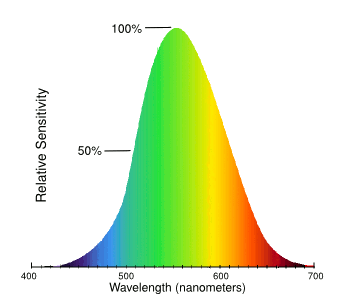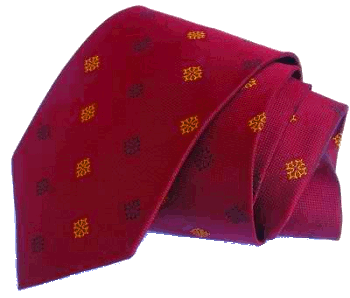Psychology of Red
August 15, 2012
The
color,
red, evokes some
stereotypes. Red is the color of
danger, presumably because it's the color of
blood. That's probably why we have red
stop lights and red
stop signs. There's also the idea that
bulls are attracted to the
matador's cape because it's red. All
cattle, including bulls, are
colorblind, so the color is irrelevant. The actual reason is because the cape is a large, moving object.
Scientists know that red is a bad color choice for an object you want to be seen. The
human eye sees green objects much better than red objects (see figure). So, should our red stop lights and red stop signs actually be green? These exist in a background environment that's mostly green, at least in areas where
trees are still allowed to grow, so red is probably still a good color choice for
contrast's sake.

Color sensitivity of the human eye.
The way you develop such a curve is by asking study participants to equalize the perceived intensity of various pairs of colored lights, and then churning through the math.
(Via Wikimedia Commons, modified))
There is another, more technical, reason for using red light in a warning
beacon.
Rayleigh scattering, which is the scattering of
light as it propagates through the
atmosphere, is somewhat less for the longer wavelength red light than shorter wavelength
blue and green light. There's only a factor of two difference in scattering over the visible color range, but every bit helps.
The
physical properties of red are very easy to state. Red is just that portion of the
electromagnetic spectrum between 630 and 700
nanometers. When we ask about the human sensation of red, the "quality of redness," we've opened up a
philosophical discourse that I mentioned in a
previous article (The Quality of Chairness, December 3, 2010).
The
psychological properties of red have been studied extensively.
Experiments by
psychologists at the
University of Rochester have shown that men are attracted to women wearing red, and
vice versa.[1-3] Other Rochester experiments have shown that humans react more forcefully and more quickly when they see red, but they have no idea that the color has affected them.
In one experiment,
undergraduate students squeezed a handgrip as hard as possible whenever they saw the word, "squeeze," on a
computer display. The word was displayed on a red,
gray or blue background. A red background caused a significant increase in the exerted
force and the
speed of their response.[4-5] I wrote about these experiments in a
previous article (Power Tie, June 9, 2011).

Power Tie
Businessmen believe that a red necktie advertises power.
Psychological studies indicate they may be correct.
(Via Wikimedia Commons, modified))
The logo of my
former employer is entirely red. The
Wikipedia page for "Red" lists seventy-seven major companies with red in their
logos, from
Avis to
Wendy's, and
Kmart in between. Perhaps the reason I don't get much business is because my logo is blue.
It comes as no surprise that those red logo companies and many others are using psychology to sell more products at higher prices. One article in the
Journal of Consumer Research focuses on the power of the color, red, as a tool for greater profitability.[6-7]
In an
online auction, a red background will cause bidders to act more aggressively and make higher bids. However, when a person was not in competition with a corp of online bidders, but rather just dealing with a seller in a one-on-one basis, a red background reduced the willingness to buy a product, but a blue background caused the buyer to offer a higher price.[6]
One study, at the
Cornell University Food and Brand Lab showed that placement of red
potato chips at intervals in tube-type potato chip containers acted as a subconscious signal to stop eating.
College students, who were the study subjects, ate about half as many chips when the red chips were present.[8-10]
Said
Brian Wansink, director of the Cornell University Food and Brand Laboratory,
"People generally eat what is put in front of them if it is palatable... An increasing amount of research suggests that some people use visual indications, such as a clean plate or bottom of a bowl, to tell them when to stop eating."[8]
Another article in Journal of Consumer Research showed that consumers are more likely to choose a product in the lateral
center of a
display case.[11-12] This is an important result, since it affects everything from items in a
vending machine to
vitamins in a
health food store. The research was done using
eye-tracking devices that found that
consumers tended to focus on the display center in the final five seconds before making a choice.[12]
In the spirit of "
forewarned is forearmed," next time I'm in the
supermarket I'll try to give equal time to those lonely products at the edge of the shelves.
References:
- Susan Hagen, "Psychological Study Reveals That Red Enhances Men's Attraction to Women," University of Rochester Press Release, October 28, 2011.
- Liz Hurley, "Wearing red 'boosts attraction'," BBC News, October 28, 2008.
- Susan Hagen, "Women Attracted to Men in Red, Research Shows," University of Rochester Press Release, August 2, 2011.
- Susan Hagen, "Color Red Increases the Speed and Strength of Reactions," University of Rochester Press Release, June 2, 2011.
- Andrew J. Elliot and Henk Aarts, "Perception of the color red enhances the force and velocity of motor output," Emotion, vol. 11, no. 2 (April, 2011), pp. 445-449.
- Mary-Ann Twist, "Selling on eBay? Get higher bids with a red background," University of Chicago Press Journals Press Release, July 16, 2012.
- Rajesh Bagchi and Amar Cheema. "The Effect of Red Background Color on Willingness-to-Pay: The Moderating Role of Selling Mechanism." Journal of Consumer Research: February 2013.
- Sandra Cuellar-Healey, "Red potato chips: Segmentation cues can substantially decrease food intake," Cornell University Food and Brand Laboratory Press Release, July 24, 2012.
- Rachel Eklund, "Will you eat less if your food had “STOP” signs?," Cornell University Food and Brand Laboratory, February 21, 2012.
- A. Geier, B. Wansink & P. Rozin, "Red potato chips: Segmentation cues can substantially decrease food intake," Healthy Psychology, Vol, 31, no. 3 (May 2012), pp. 398-401..
- Mary-Ann Twist, "Are consumers aware that they are drawn to the center when choosing products?" University of Chicago Press Journals Press Release, July 16, 2012.
- A. Selin Atalay, H. Onur Bodur, and Dina Rasolofoarison. "Shining in the Center: Central Gaze Cascade Effect on Product Choice." Journal of Consumer Research: December 2012.
Permanent Link to this article
Linked Keywords: Color; red; stereotype; danger; blood; traffic light; stop light; stop sign; bull; bullfighting; matador's cape; cattle; colorblind; scientist; human eye; color vision; green; tree; contrast; intensity; mathematics; Wikimedia Commons; beacon; Rayleigh scattering; light; atmosphere; blue; physical property; electromagnetic spectrum; nanometer; philosophy; philosophical discourse; psychology; psychological; experiment; psychologist; University of Rochester; undergraduate student; computer display; gray; force; speed; businessperson; Businessmen; necktie; Honeywell Aerospace; former employer; logo; Avis; Wendy's; Kmart; Journal of Consumer Research; online auction; center; display case; vending machine; vitamin; health food store; eye-tracking device; consumer; forewarned is forearmed; supermarket.